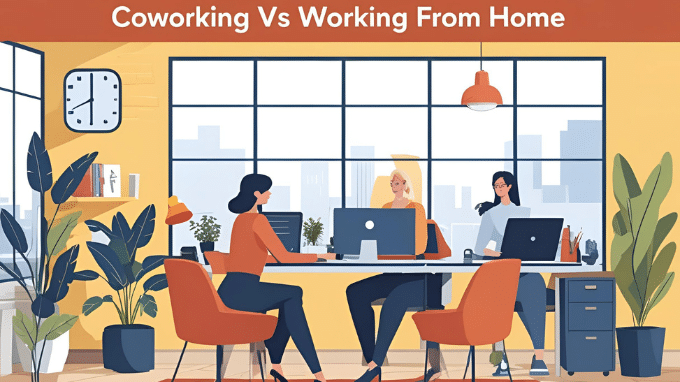Coworking vs Working from Home: What You Need To Know

Remote work has evolved from a luxury to a lifestyle—and in 2025, it’s no longer a one-size-fits-all setup. While some professionals thrive in their home office, others are finding that coworking spaces offer structure, focus, and social energy they didn’t know they were missing. So, when it comes to staying productive, which setup really works better?
Whether you’re a freelancer, remote employee, or running your own business, understanding the trade-offs between coworking vs remote work can help you make smarter decisions about how—and where—you work.
In this guide, you’ll learn:
- The pros and cons of coworking vs remote work
- Real-world insights on productivity work from home vs shared office spaces
- Key remote work productivity tips based on current trends
- How to evaluate the best work environment for productivity based on your needs
Remote Work in 2025: What’s Changed?

In recent years, remote work has gone from a temporary fix to a permanent option for millions. According to Gallup’s latest report, nearly 60% of U.S. professionals now work remotely at least part-time. This shift has opened the door to more flexible lifestyles—but it’s also forced many workers to rethink their daily routines.
Working from home might seem ideal, but distractions, isolation, and lack of structure can wear down even the most motivated employees. At the same time, coworking spaces have seen a surge in popularity, especially among those craving connection, creativity, and routine.
Choosing the right setup depends on your work style, goals, and day-to-day needs—and that’s exactly what we’ll help you figure out.
Read next: Creating a Productive Home Office Environment
Coworking vs Working from Home: Breaking Down the Pros and Cons
Pros Of Coworking Spaces
Structure and Routine
Coworking gives you a rhythm to your day. Getting up, commuting, and settling into a desk provides a sense of purpose and routine that working from home sometimes lacks.
Networking Opportunities
You’re surrounded by people—freelancers, founders, marketers, designers. Whether it’s casual conversation or formal events, coworking offers natural networking that can lead to job leads, collaboration, or even friendships.
Fewer Distractions
Most spaces are built for focus. You’ll find quiet rooms, soundproof booths, fast internet, and a professional vibe that helps many people stay in work mode.
Separation of Work and Home
When your office isn’t your kitchen table, it’s easier to log off at the end of the day. That mental separation helps reduce burnout and preserve your downtime.
Cons Of Coworking Spaces
Cost
Memberships range widely—from $150 a month for a hot desk to $600+ for a private office. It’s a recurring expense that not every budget can accommodate.
Commute
Even if it’s a short trip, leaving your home to get to a coworking space still takes time and planning. For some, that daily effort isn’t worth it.
Read next: Freelancer vs. Full-Time Employment: Which Earns More in 2025?
Noise and Shared Resources
Most spaces are quiet, but shared kitchens, phone booths, and communal areas can lead to the occasional distraction. If you’re extremely noise-sensitive or need privacy, it may not be ideal.
Pros Of Working from Home
Convenience
Your home is your office. You can wake up and be at work in minutes. No traffic, no train delays, no packing lunch.
Cost Savings
You don’t need to pay for office space, commuting, or even daily coffee. Over time, that adds up.
Customization
From standing desks to playlists to your favorite lighting, you can design a workspace that feels completely yours. It’s the most flexible option available.
Flexibility
Perfect for those with caregiving responsibilities, health concerns, or anyone who values managing their own schedule.
Cons Of Working from Home
Isolation
Without coworkers or daily social contact, loneliness can creep in. Many remote workers struggle with feeling disconnected.
Distractions
Kids, roommates, deliveries, dishes—it’s easy to get sidetracked.
Blurry Boundaries
Work and home can start to blend. When your laptop is always nearby, it can be hard to switch off at the end of the day.
Motivation Slumps
Some people need external accountability to stay productive. At home, without coworkers or managers nearby, motivation can dip.
Understanding the upsides and downsides of coworking vs remote work can help you make a more informed decision about where—and how—you do your best work.
Productivity: Which Setup Works Better?
There’s no universal answer, but trends and studies offer some guidance. A 2024 Buffer survey showed that remote workers who regularly switch environments—such as splitting time between home and a coworking space—report higher job satisfaction and better time management.
So how do you decide the best work environment for productivity?
Ask Yourself:
- Do I feel energized or drained working alone all day?
- Am I easily distracted by home responsibilities?
- Do I crave community or external accountability?
- What’s my budget for workspace expenses?
If you’re nodding along with “yes” to distractions, fatigue, or isolation, a coworking membership—even part-time—could boost your energy and output.
Read next: How The Creator Economy Is Redefining Traditional Careers In The U.S.
Remote Work Productivity Tips (That Actually Work)
Staying productive at home takes intention. If you’re sticking with a home office, here are some practical remote work productivity tips that make a difference:
- Stick to Set Hours: Start and stop your workday consistently.
- Get Dressed for Work: Yes, even if no one sees you—it primes your brain for focus.
- Use a Dedicated Work Zone: Avoid mixing your workspace with your relaxation areas.
- Take Real Breaks: Step outside, stretch, or eat lunch away from your screen.
- Use Productivity Tools: Try apps like Notion, Trello, or Focus Keeper to stay organized.
- Stay Connected: Schedule regular check-ins or virtual coffee chats with coworkers or peers.
When practiced consistently, these habits turn your home into a productive and sustainable work environment.
Coworking Productivity Hacks

If you’re leaning toward coworking, maximize your membership with these tips:
- Pick the Right Space: Visit a few before committing. Look for clean layouts, quiet zones, and community events.
- Use Time Blocks: Structure your coworking days around your most focused work.
- Join Events or Workshops: Many coworking hubs offer member-only sessions that can support both learning and networking.
- Stay Organized: Bring noise-canceling headphones, a backup charger, and your essentials to minimize distractions.
Blending your environment with intentional work habits is where coworking really shines.
Hybrid Work: The Best of Both Worlds?
More professionals are blending both setups—working from home a few days a week, then heading to a coworking space for focused sessions or meetings. This hybrid approach helps you manage costs, reduce isolation, and avoid burnout.
If you’re debating coworking vs remote work, know that it doesn’t have to be an either-or decision. The best work environment for productivity could very well be a blend of the two.
Design Your Workday with Intention
Whether you thrive in solitude or feed off the buzz of others, the key to productivity is finding the right space for your brain to do its best work.
The battle between coworking vs remote work isn’t about which is better overall—it’s about which one fits your lifestyle, goals, and daily energy best. Both have their place, and both can help you succeed.
Try both, track your focus, and design a setup that works for you. Your environment is part of your strategy—treat it that way.





